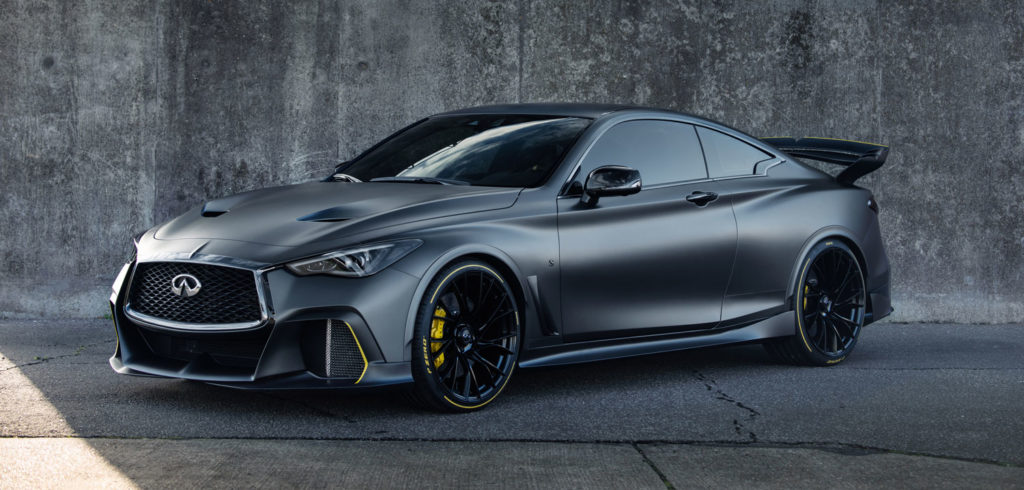Infiniti and Renault F1 Team have completed track development of the high-performance, dual-hybrid powertrain created for the Infiniti Project Black S prototype. Renault F1 team driver Nico Hülkenberg put the two prototypes through their paces at the Salzburgring in Austria.
Infiniti will continue to test and validate elements of the Q60 Project Black S prototype and will make a decision on the production potential of the car and its technologies by the end of 2019.
The latest version of the Project Black S was revealed in Paris in fall 2018. Since then, powertrain engineers from Renault F1 Team and Infiniti have developed the technology further, exploring whether it could be deployed in a high-performance road car. Furthermore, the program has provided an insight into how Infiniti can work hand-in-hand with partners on developing new projects and technologies.
Mike Colleran, deputy chairman, Infiniti Motor Company, commented, “The work that has gone into Project Black S represents a milestone in Infiniti’s road to electrification. This testbed for new ideas, and rapid development, represents everything Infiniti hopes to achieve with its electrified cars in future, such as smart energy management from advanced high-performance powertrains, a thrilling drive, and a performance aesthetic.”
Cyril Abiteboul, MD of Renault F1 Team, said, “Infiniti’s experience of working with homologated hybrid powertrain technology was instrumental in the co-development of our dual-hybrid system. The Black S project gives us a rare opportunity for direct transfer of genuine F1-honed technology back into a road car. Making this leap from circuit to road is something we are incredibly excited to be involved in.”
New ways of working and production potential
A key aim of the Project Black S program was to explore the potential for new motorsport-inspired electrification technologies and development processes. Project Black S combines expertise from road and racetrack, with its dual-hybrid powertrain, purpose-built brakes, and special suspension system, all complemented by the use of advanced lightweight materials throughout the bodywork and a motorsport-inspired interior.
Colleran, commented, “Working with Renault F1 Team has opened our eyes to new ways of working. Outside of the traditional process in which we engineer cars and technologies, this collaboration has shown us what can be achieved with a small, dedicated team. We will learn from this to enhance the way we create other cars in future.”
Dual-hybrid powertrain technology
The test vehicle is based on the Infiniti Q60 sports coupe with its 400hp VR30 twin-turbo V6 engine, and dual-hybrid system, which combines supercar performance with smart energy management.
The VR30 engine has been transformed with the creation of two heat-energy harvesting systems (MGU-H: motor generator unit – heat), which develop electricity under acceleration. Paired with a kinetic harvesting system (MGU-K: motor generator unit – kinetic) that generates electricity under braking and an all-new energy management system, Project Black S is a unique electrified performance hybrid prototype.
In a similar manner to Renault F1 Team’s R.S.19 race car, the Project Black S’ smart powertrain stores this energy and discharges it as the driver requires, spooling up the turbochargers instantaneously as the driver opens the throttle, boosting power sent to the rear wheels via the MGU-K over continued periods of acceleration.
Currently, the dual-hybrid powertrain is capable of producing up to 418kW (568ps, 563hp) – 40% more than the prototype’s donor car, the Infiniti Q60 Red Sport 400. Uniquely, it provides sustained and sustainable hybrid performance, delivering electrically assisted acceleration, lap after lap.
The prototype offers drivers complete control over how the powertrain uses this energy, with three Formula 1-inspired drive modes – Road, Quali and Race – each altering the way in which the powertrain harvests and discharges power.
“There is still work to be done. Now we have two completed prototypes, we will fully evaluate the production potential of Project Black S. It is still too early to predict the outcome as we need a solid business case, but the latest rounds of testing have proved its unique performance and underlines our pursuit of electrified performance. This is an exciting phase of the process. We will consider every element of the development prototypes to establish the feasibility of volume or limited production in future,” Colleran concluded.


